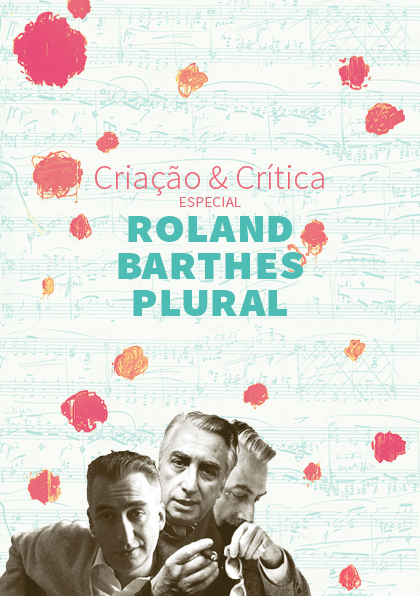A presentpainting. A brief incursion in Roland Barthes’ drawings.
DOI:
https://doi.org/10.11606/issn.1984-1124.v0ispep123-129Keywords:
Painting, Roland Barthes, Trace, Present, Writing, Anacoluthia.Abstract
Indian ink, gouache, watercolour: Barthes’ fluid trace is an attempt to capture the vanishng instant, the floating inscription signs of every Sunday morning in which he used to produce his ink blots, as he says himself.It certainly is an instant of significance for him who traces and paints, but at the same time it is a gift : Barthes inscribes his body in a fragile material – usually a very thin sheet of paper as those letterheads from the École des Hautes Études – not in order to afirm himself as an artist, but for the simple pleasure of dedicating this amateur gesture to his friends, presenting them with his production. The pictorial gesture in Barthes happens, therefore, as a sign of anacoluthia, i.e. the rare space in which our ideas penetrate each other with afect, in which friends, by walking by our side and by sharing our path, allow us to think, write, speak. In this paper I analyse the pictorial gesture in Roland Barthes not only as producing gesture, regarding the signs that delightedly vacilate between letter and image, but essencially as an offering one.
Downloads
References
BARTHES, Roland. “A Imagem” in: O rumor da língua. Tradução: Mario Laranjeira. São Paulo: Martins Fontes, 2004.
BARTHES, Roland. O Império dos signos. Tradução: Leyla Perrone-Moisés. São Paulo: Martins Fontes, 2007.
BARTHES, Roland. O prazer do texto. Tradução: Jacó Guinsburg. São Paulo: Perspectiva, 2013.
BARTHES, Roland. Œuvres Complètes Vol. IV. Paris: Seuil, 2002d.
BARTHES, Roland. Œuvres Complètes Vol. V. Paris: Seuil, 2002e.
BARTHES, Roland. “Semiografia de André Masson”, in: Óbvio e obtuso. Ensaios críticos III. Tradução: Léa Novaes. 2 edição. Rio de Janeiro: Nova Fronteira, 1990, pp. 139-141.
CAMUS, Renaud. “Nada a dizer ou a inteligência nua”, in: Roland Barthes, artista amador: coleção Romaric Sulger Buel. Rio de Janeiro: CCBB, 1995.
GENETTE, Gérard. “ Un jardin sur l’adour”, in : R/B: Roland Barthes, Paris: Seuil, 2002.
SAMOYAULT, Tiphaine. Roland Barthes. Paris: Seuil, 2015.
Institut National du Patrimoine. Disponível em <http://www.bnf.fr/fr/collections_et_services/anx_tresors_patrimoine/a.c_120605_dessins_barthes.html>. Acesso em 02/06/2015.
INA . Disponível em <http://www.ina.fr/video/CPF10005880>. Acesso em 02/06/2015.
Downloads
Published
Issue
Section
License
Authors who publish with this journal agree to the following terms:
- Authors retain copyright and grant the journal right of first publication with the work simultaneously licensed under a Creative Commons Attribution License that allows others to share the work with an acknowledgment of the work's authorship and initial publication in this journal.
- Authors can enter into separate, additional contractual arrangements for the non-exclusive distribution of the journal's published version of the work (e.g., post it to an institutional repository or publish it in a book), with an acknowledgment of its initial publication in this journal.
- Authors are permitted and encouraged to post their work online (e.g., in institutional repositories or on their website) before and during the submission process, as it can lead to productive exchanges, as well as earlier and greater citation of published work (See The Effect of Open Access).



